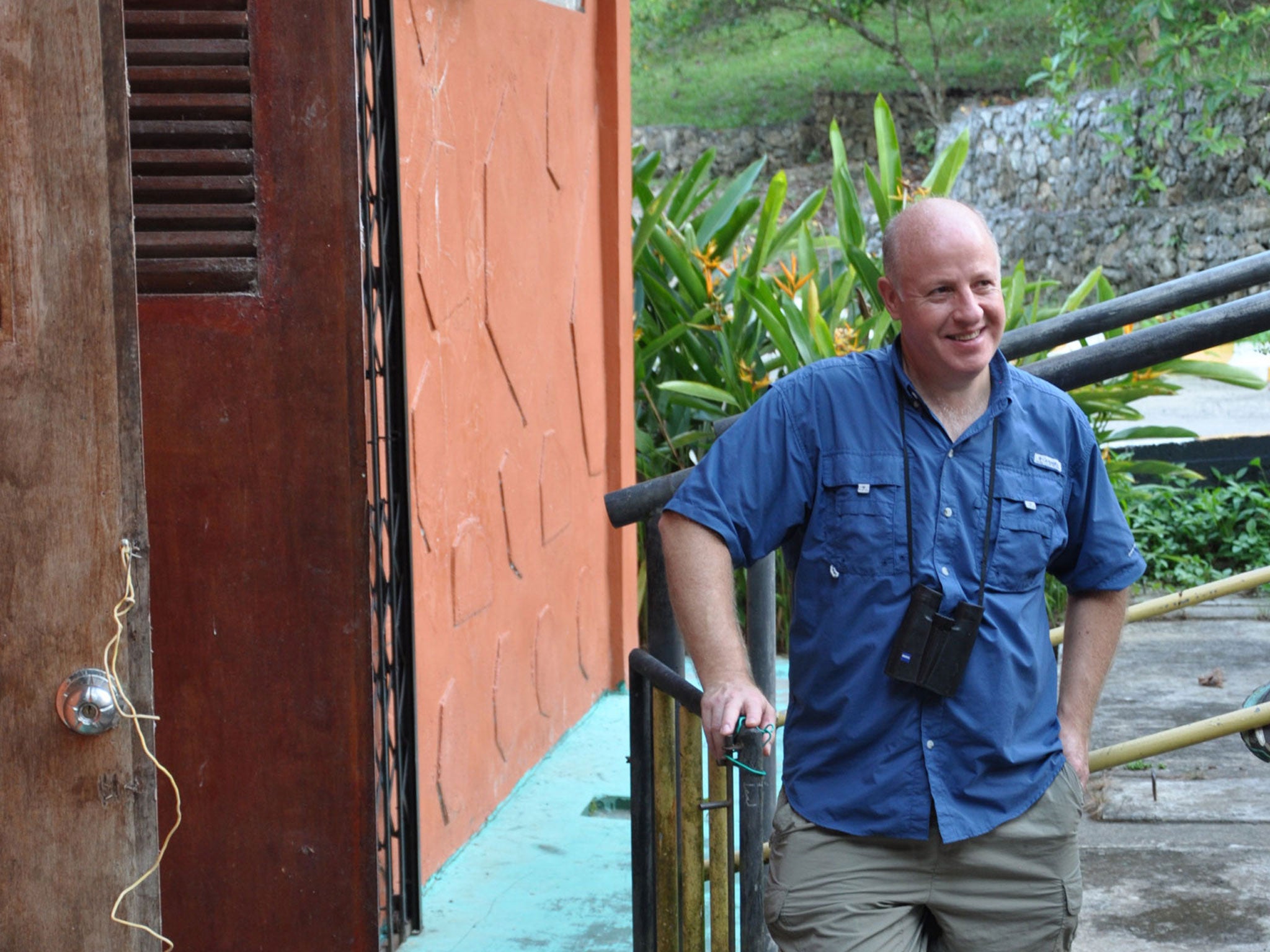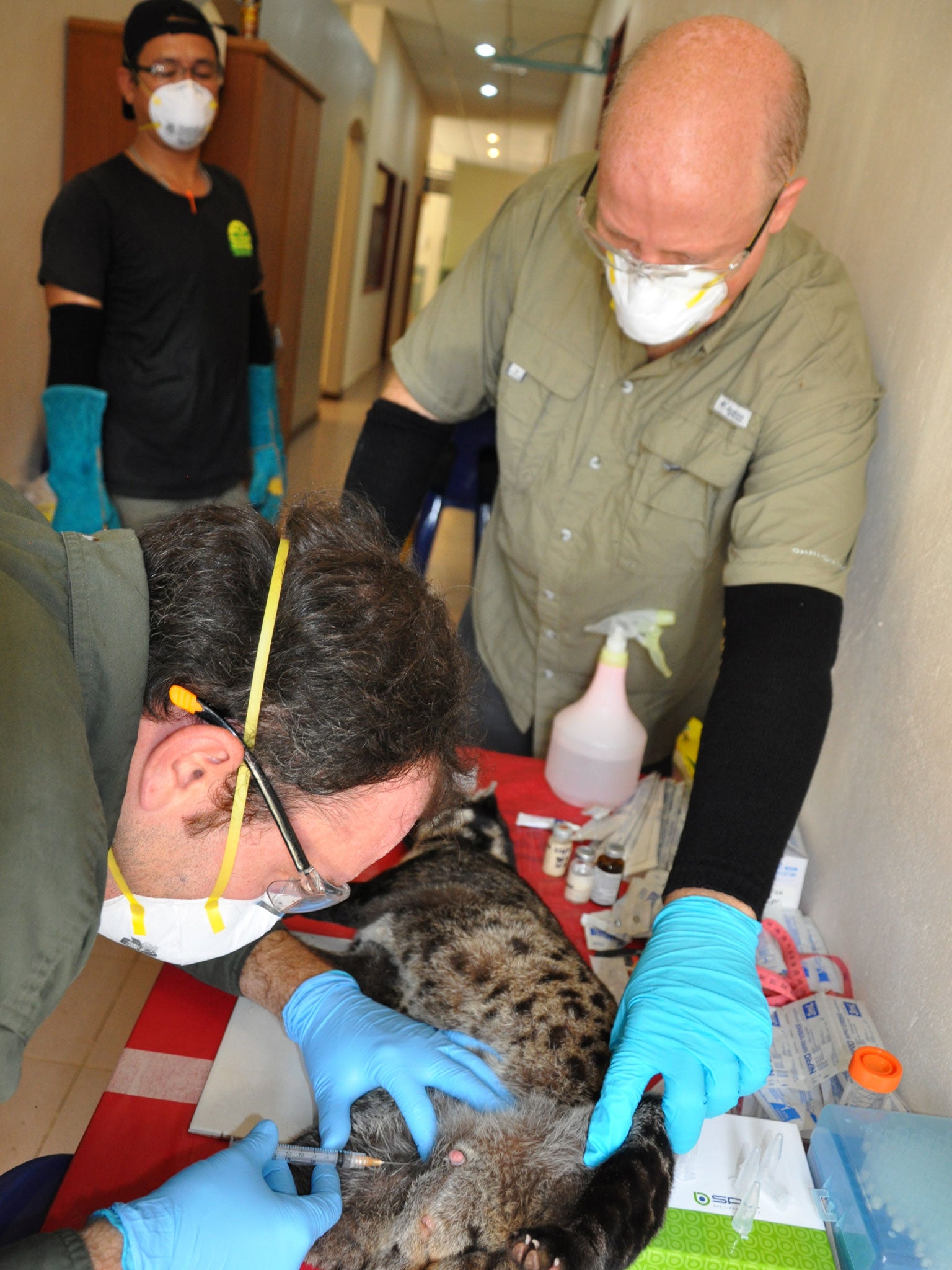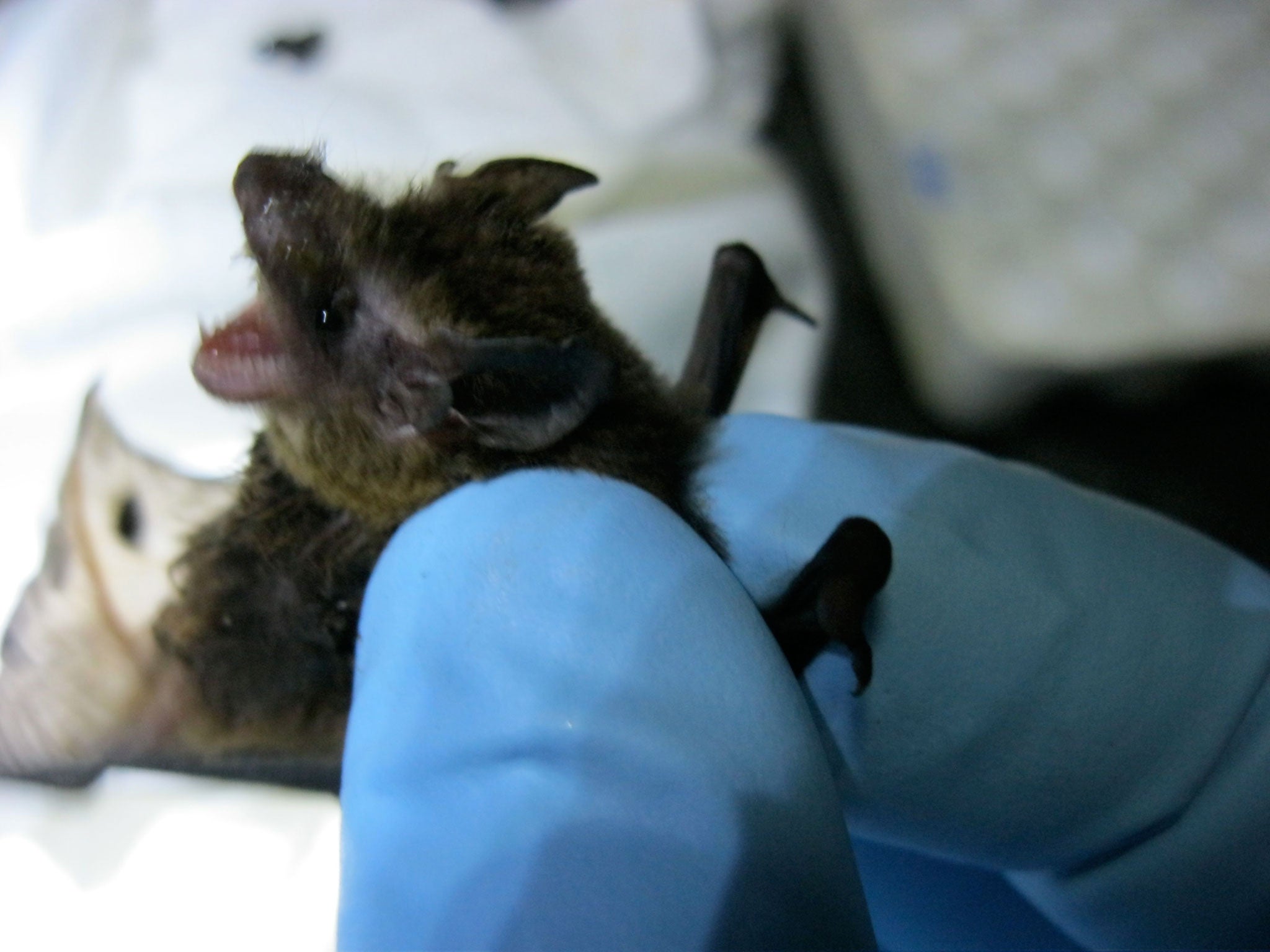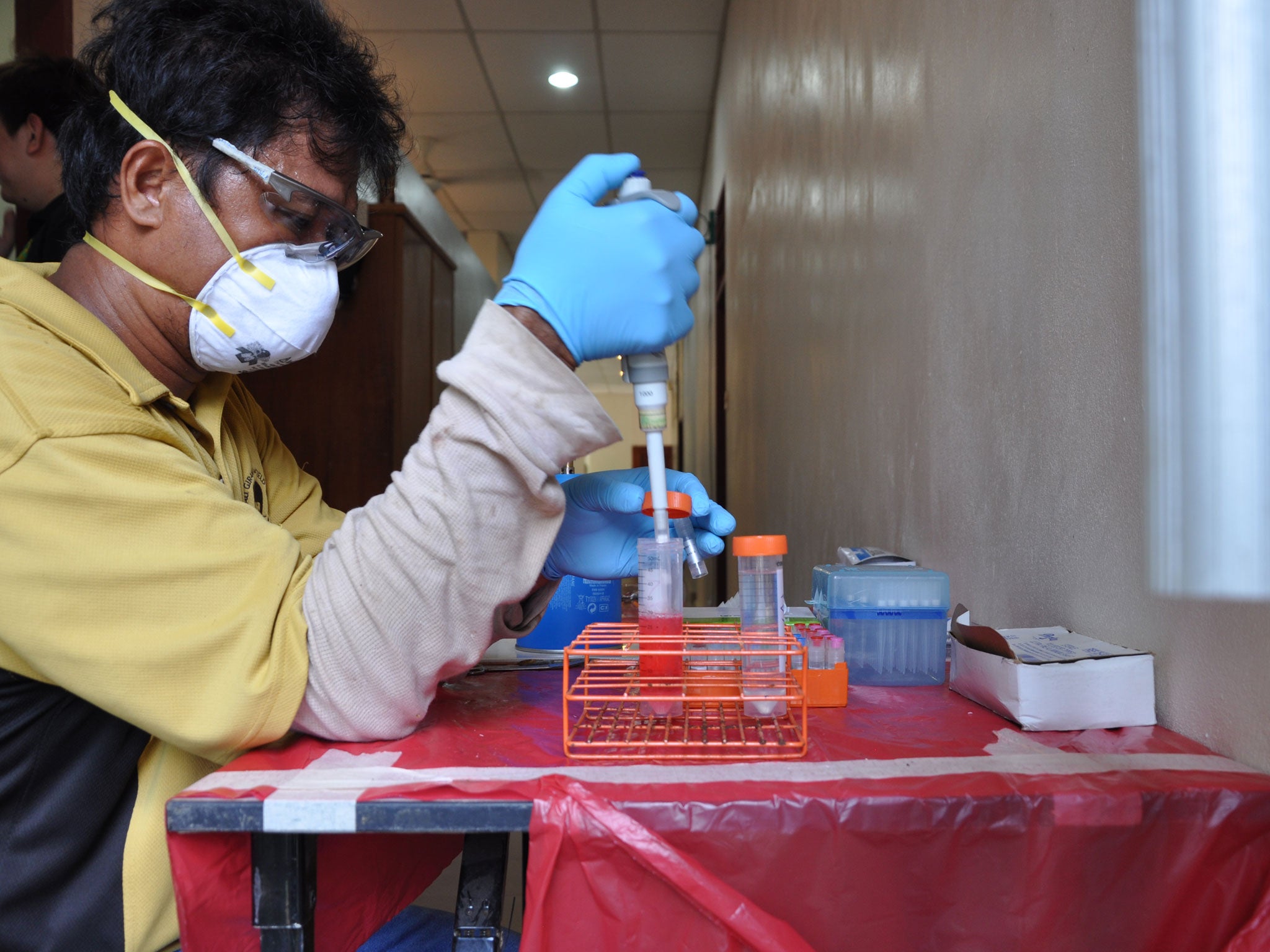How a team of scientists in Borneo are working up to stop the next pandemic
Deep in the Borneo rainforest, Charlie Cooper joins a team of scientists tracking the animals that could host deadly viruses

Your support helps us to tell the story
From reproductive rights to climate change to Big Tech, The Independent is on the ground when the story is developing. Whether it's investigating the financials of Elon Musk's pro-Trump PAC or producing our latest documentary, 'The A Word', which shines a light on the American women fighting for reproductive rights, we know how important it is to parse out the facts from the messaging.
At such a critical moment in US history, we need reporters on the ground. Your donation allows us to keep sending journalists to speak to both sides of the story.
The Independent is trusted by Americans across the entire political spectrum. And unlike many other quality news outlets, we choose not to lock Americans out of our reporting and analysis with paywalls. We believe quality journalism should be available to everyone, paid for by those who can afford it.
Your support makes all the difference.The bat was so tiny that it easily fitted into the palm of Jimmy Lee's hand. It had come along just in time. In the darkness of the Borneo rainforest late one evening earlier this month, Lee Lee from EcoHealth Alliance and the rest of a seven-strong team from Sabah's Wildlife Health Unit, a collaboration between EHA, Sabah Wildlife Department and Danau Girang Field Centre were on the point of calling it a night. And then the little creature flew right into one of their nets, their first catch from a shift that had lasted 12 hours.
Above the trees, the moon and stars were out. And contrary to what Halloween tells us, bats don't like to fly when the moon is bright. But this single specimen – a spotted-wing fruit bat – made the evening's effort worthwhile. The team packed up their nets and set off back to base, a half-hour trek and drive to a sparse building that by day serves as a visitor centre for the nearby Gomantong Caves. Most likely these caves were where the bat, along with a million others, had his roost.
Lee, a 27-year-old biotechnology graduate of Kuala Lumpur's UCSI University, gently laid the creature on a table in the visitor centre and looked for a tiny vessel in its wing. He found it and extracted a few drops of the creature's blood. After taking swabs to get the other samples the team needed, Lee set the bat down on a nearby tree branch, high enough up to keep it away from predators. In an instant the bat flew off, back into to the dark of the jungle, never to be seen again. But during its brief period of captivity it had helped serve a purpose whose importance to mankind could hardly be overstated.
Contained in the small vial of blood that the bat left behind was in all likelihood the thing the team was really looking for: viruses. Further testing might well uncover dozens of them, some of them pathogens unknown to science. Most would probably be harmless. But some might have the ability to cross into human beings. And any one of those could be the cause of the next deadly epidemic – the next Ebola. The next HIV.
Tonight's catch is just one of thousands of mammals that the EcoHealth Alliance has trapped, sampled and surveyed for viruses in Borneo during the past six years. Their work is part of an intensifying global hunt for deadly microbes. HIV, the Sars virus, and Ebola all sprang from wildlife, and researchers are exploring the depths of some of the world's great wildernesses – such as the Malaysian Borneo rainforest – in an attempt to head off the diseases that might otherwise succeed them.
It seems improbable that a virus from a wild animal living in such an environment could be the cause of a deadly human plague. But in fact, 75 per cent of the new diseases affecting humans today have their origins in animals. Rain- forests, with their unparalleled bio- diversity and relative isolation from man, represent a potentially seething repository of unknown pathogens.
It was almost certainly a bat, living in a forested part of Guinea, that carried the strain of Ebola that has gone on to kill 11,300 people in West Africa. An even more devastating virus, some time in the early 20th century, jumped from a chimpanzee to a human being, probably a bush-meat hunter, somewhere in Central Africa. For decades it circulated in the region undetected before spreading globally and infecting millions. It was not until the mid-1980s that scientists knew what they were dealing with and gave the virus a name: HIV.
Monumental as the global effort to control HIV has been, nearly 40 million people have died from the disease, with astronomical sums of money spent on treatments. Human culture has been scarred for ever. But what if we could have stopped HIV, Ebola and other animal-origin viruses at source? What if scientists had known that chimpanzees carried a virus that, if transferred to humans, could be deadly? What if they had warned bush-meat hunters about the risks, and managed to contain the virus within a few small villages?
In Borneo, with funding from the US government, teams from EHA is trapping and taking samples from a huge range of rainforest mammals. Its lab has run 8,000 samples from 2,000 individual animals – bats, rodents, monkeys, civets, orangutans. The samples are scanned for viruses, which can be traced back to their animal host. With this knowledge, the theory goes, health authorities would be able to crack down on chains of transmission and warn the public about possible dangers, while preparing hospitals and beginning research for a vaccine – all in time to prevent the virus spreading out of control.
Dr Peter Daszak is the parasitologist who leads EHA's work in more than 20 countries around the world. Aged 49 and from Manchester, Daszak is convinced that this approach could have prevented the Ebola outbreak – and might yet defend us against the next pandemic disease.

"Had people been doing this kind of work in West Africa, we would have found Ebola in the bats there," he says, sitting in the front of a 4x4 on a pot-holed road near the Kinabatangan River > in Malaysian Borneo. "We would have been prepared. There are people living here with viruses that they are picking up from wildlife. We don't know about them. They are slowly transmitting from one to another and eventually could evolve better transmission and become the next HIV."
So why Borneo? Analysis of disease emergence over the past 50 years suggests that two things are necessary to create a "hot spot" where viruses are especially likely to cross over from animals to people: dense human population and high wildlife diversity. In Borneo, one of the oldest rainforests on Earth is being chopped down at a furious pace to make way for the planting of oil palms – and thousands of workers are migrating to harvest them.
More and more human beings now find themselves living cheek by jowl with wildlife – and the viruses they carry – which in the natural order of things they would never have encountered. Such encroachments into once-pristine wilderness are occurring throughout Asia, Africa and South America. Viruses that were once contained in the jungle could be unleashed to deadly effect.
Air travel and global trade mean that a virus can rapidly go international
To stop the next outbreak, Dazsak believes we need to know what we are up against. So it was that later that night, he was out in the rainforest with Jimmy Lee trying to trap bats. With them was Tom Hughes, a 36-year-old one-time tree surgeon from south west London, who leads EHA's work in Malaysia, plus four rangers, seconded from SWD Wildlife Rescue Unit and DGFC. EHA teams out in the field are typically a mix of international experts and local conservationists and researchers.
Nets known as mist nets – a fine, soft mesh between two poles, that can trap a bat or bird without harming it, had been strung up. They might be high in the trees, or close to the ground – anywhere they might catch a passing bat. Every night the creatures fly out from the Gomantong Caves and into the jungle in search of insects and fruit: each one, according to EHA research, potentially hosting dozens of different viruses of types that have been known to cause human disease.
Last year, in samples from two species of roundleaf and horseshoe bat, EHA researchers uncovered a new virus closely related to the coronavirus that caused the Sars pandemic of 2003. Sequencing of the virus's DNA to be carried out in the coming year, will reveal whether it could cross over into humans.

EHA researchers will also soon begin the next phase of their work: taking blood samples from the people who work near the Gomantong Caves, who include harvesters of the edible nests built by the thousands of swifts that roost there.
"We may catch a virus red-handed crossing over," Hughes says. "If people had been doing this in the early 20th century in those African villages, we might have known that HIV had made the leap and controlled it there and then. So many lives might have been saved."
It has been a roundabout way into pandemic prevention for Hughes, who on a conservation expedition to Malaysia a decade ago discovered that the climbing skills he once deployed in pruning oaks in Richmond Park were equally applicable to bat-catching. Several years and a London School of Hygiene and Tropical Medicine diploma later, he now lives in Kuala Lumpur, and spends his days either in the field or feeding back to the Malaysian government and the US Embassy about EHA's work.
After setting up traps for ground-dwelling mammals, the team sat and waited. As darkness fell, the evidence of animal life was all around us. A giant flying squirrel launched itself from a tree-top. Countless hidden insects, frogs and birds created a wall of sound. The sonorous "cuck-caw" of a rhinoceros cornbill returning to its roost stood out.
The noises, the smells, the shadows all make for spooky work. Ttalk of pandemics and viral fevers subsided. When a weird guttural hoot came from nearby treetops, the team lifted their torches in search of an orangutan. But if there was one there, it had decided to observe proceedings quietly from its hiding place. It would be a long wait before Lee caught his bat.
Experts believe that work like that carried out by EHA teams could prove as revolutionary in preventing infectious diseases as the anti-smoking campaign has been. By the end of the last decade, scientists were waking up to the potential for infectious diseases to go quickly from isolated outbreaks to full-scale pandemics.
Modern air travel and global trade mean that a new virus passing from animals to humans in even the most remote parts of the world can rapidly go international. Influential books by virologists including Nathan Wolfe and the science writer David Quammen warned of a new pandemic age of animal-to-human cross- overs made more and more likely by our insatiable encroachment into ancient ecosystems. Calls for a global network of so-called "virus-hunters" led the United States government to set up the Emerging Pandemic Threats (EPT) programme – funding prevention, detection and control of potential outbreaks the world over. Their "Predict" programme – now in its second wave – is spearheaded in Borneo by EHA.

Leading figures in global health like Dr David Nabarro – who helped co- ordinate the United Nations' response to the H1N1 and H5N1 flu pandemics and was appointed as United Nations general secretary Ban Ki Moon's special envoy on Ebola – believe that understanding the viruses running wild in the animal kingdom will be crucial to the future of human health.
"For me the Ebola outbreak has made ever stronger my determination to encourage this kind of predictive work," he says. "Everything we've learned is that we need to get upstream with these kind of challenges to human health security. Step one is to be able to prepare better for them. Step two is to be able to prevent them. Step three is to be able to predict them.
"As the majority of emerging pathogens cross over from the animal kingdom into the human population, work to understand the distribution of pathogens that have potential to cross over is really, really important. It's the kind of thing that doesn't make the headlines but it is the kind of thing we need to keep our world a safer place."
There was a time when EHA only did conservation work. Based in New York, the organisation was founded in the 1970s by the zoologist and writer Gerald Durrell as the American wing of his wildlife charity. Under the aegis of Dr Daszak – a zoologist who specialised in parasites before becoming one of the world's leading authorities on the intricate links between animal and human health – the organisation now finds itself at the frontier of this new scientific field.
The morning after they caught their bat, the team headed back into the forest to check the mammal cage-traps. When he was growing up, Daszak kept vipers as pets in his bedroom, and he stopped the car on the forest road in order to examine a particularly fine monitor lizard. But working in pandemic prevention has shifted his focus from reptiles to mammals: our animal relatives, and those most likely to seed a virus that could be deadly to humans.
We don’t feel much danger as a species, do we? We’ve conquered everything
To get an idea of the scale of the challenge faced by the virus hunters – a term Daszak considers slightly gung-ho, preferring (as a naturalist would) the less interventionist "virus spotters" – between 2010 and 2011 EHA sampled individuals from a single species of bat in Bangladesh until they stopped finding new viruses. They arrived at the figure of 58 previously unknown viruses. If every mammal species in the world harbours a similar number, there are 320,000 unknown viruses out there waiting to be discovered.
Finding them all, says Daszak, would give the world a global database. Whenever a mysterious disease outbreak struck, the virus responsible could be traced back to the animal source and action could be taken to stop human contact with the animal. The scale of the work this would involve is mind-boggling but Daszak believes it can be done.
"We're just grasping round the edges this field," he says. "Fifty years ago we didn't know that smoking causes cancer but we knew something was going on. We're as ignorant of this now as we were of that then. We need to accelerate it. We need a race-to-the-moon type approach. Who wants to be the first to get the 320,000 viruses that are out there an identify them?"
For now, work in the field is focused on so-called "sentinels": groups of people from whom the "patient zero" of the next pandemic is likely to be drawn. Dr Nathan Wolfe's work concentrates on bush-meat hunters, while in China, monitoring centres on the live animal markets, like the one in Guangdong province where Sars first crossed over. Most likely it came from a civet, a cat-like mammal which is eaten in some parts of China.
Civets are common in this part of Borneo, so it is no surprise that the first trap the team check is found to contain a particularly large, handsome specimen. Very carefully, two rangers place a cloth bag over the entrance to the trap and open the door. It is with surprising force that the 5kg animal bounds into the bag, which the rangers seal up as quick as they can. The creature is still thrashing about and tearing at the cloth, so Lee makes a recommendation: as with heavy shopping, a civet this big requires double-bagging.
An hour later the civet is lying anesthetized on the table at the field lab while Hughes and Daszak extract blood, saliva, faecal and urine samples, which are then frozen in liquid nitrogen ready for transportation to the Wildlife Health, Genetic and Forensic Laboratory set up by EHA, SWD and DGFC in Sabah's state capital, Kota Kinabalu.

Lee and his team are sanguine about the risks surrounding their work, even about the occasion they were charged by forest elephants in the dead of night and had to light fires to drive them off. "Of course, if you see a sun bear, the only thing you can do is run," Lee says, with complete sangfroid.
The key "sentinel" group in Borneo are the plantation workers harvesting palm oil at sites that only a few years ago were lush, pristine jungle. Already rates of malaria and the dangerous bacterial infection leptospirosis have risen in Sabah state. When the team arrive to check on one of their plantation survey sites, they disturb a large orangutan. It immediately vanishes back into the jungle, which grows right up to the edge of the oil palm field – vividly illustrating the proximity of wildlife to humans.
Something else is also clear from these pandemic prevention efforts: the importance of slowing the frantic pace of deforestation in places like Sabah. "All it would take is someone, somewhere in Malaysia pushing into a new bit of forest, opening up a new logging camp, getting bitten by a mosquito or eating the wrong bit of bushmeat, and a virus can cross over," says Hughes.
"Then it will matter to people living in the UK, in the US, in Europe. So people should pay more attention and put some pressure on. It's not 'No to development', it's just doing it with some forethought, some planning and some monitoring, rather than just blindly charging in."
The day's work done, Daszak and Hughes have some spare time to do what they really love – observing the extraordinary diversity of wildlife that makes this rainforest their home. The nearest tourist resort to their scientific sites, which offers Robinson Crusoe-esque accommodation right on the shores of the Kinabatanagan river, also hires out motor skiffs, and as the sun begins to dip, we take one out on the river.
Crocodiles lie watchfully on the banks. A giant male proboscis monkey, with his bizarre button nose, holds court in the trees overhead. With night descending and the sky turning to red, it is hard not to feel a primal fear of the jungle and what it might contain.
"We don't feel much danger any more as a species do we?" says Daszak. "We've conquered everything. But there are these viruses whose whole modus operandi is to get inside your body, infect your cells and take them over. There's definitely a feeling that you're diving into the unknown. If we can find the viruses that are out there, and conserve these patches of land that are left, maybe we can stop the next one."
Peter Daszak, the parasitologist who leads EcoHealth Alliance's work in 20 countries, at its Borneo base. Growing up, he kept pet vipers in his bedroom
Join our commenting forum
Join thought-provoking conversations, follow other Independent readers and see their replies
Comments